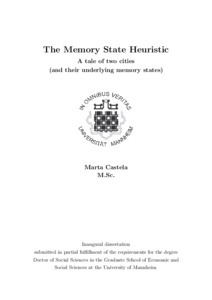|
The memory state heuristic
Castela, Marta
![[img]](https://madoc.bib.uni-mannheim.de/42278/1.hassmallThumbnailVersion/diss_Castela_FINAL-1.pdf)  Vorschau |
|
PDF
diss_Castela_FINAL-1.pdf
- Veröffentlichte Version
Download (4MB)
|
|
URL:
|
https://madoc.bib.uni-mannheim.de/42278
|
|
URN:
|
urn:nbn:de:bsz:180-madoc-422785
|
|
Dokumenttyp:
|
Dissertation
|
|
Erscheinungsjahr:
|
2016
|
|
Ort der Veröffentlichung:
|
Mannheim
|
|
Hochschule:
|
Universität Mannheim
|
|
Gutachter:
|
Erdfelder, Edgar
|
|
Datum der mündl. Prüfung:
|
14 Oktober 2016
|
|
Sprache der Veröffentlichung:
|
Englisch
|
|
Einrichtung:
|
Außerfakultäre Einrichtungen > GESS - CDSS (SOWI)
Fakultät für Sozialwissenschaften > Kognitive Psychologie u. Differentielle Psychologie (Erdfelder 2002-2019)
|
|
Fachgebiet:
|
300 Sozialwissenschaften, Soziologie, Anthropologie
|
|
Normierte Schlagwörter (SWD):
|
Entscheidungsverhalten , Wiedererkennen , Heuristik
|
|
Freie Schlagwörter (Englisch):
|
Recognition heuristic , memory-state heuristic , decision-making , recognition memory , cognitive modeling
|
|
Abstract:
|
The recognition heuristic (RH) is one of the most prominent models of inferential decision making, but also one of the simplest. Its basic premise is straightforward: Whenever a decision maker is evaluating two objects according to a given criterion (e.g., population size), one object being recognized and the other not, recognition by itself is used to make an inference, ignoring all further knowledge one might have about the recognized object (Goldstein & Gigerenzer, 1999). Surprisingly, this simple strategy can be quite accurate. This accuracy stems from an exploitation of the environmental structure. In fact, for objects in many domains (e.g., world cities) there is a correlation between recognition and the corresponding criterion value (e.g., population size). For example, if a city name is recognized and another one is not, the former city is likely to be more populous than the latter one. Goldstein & Gigerenzer assumed this to be the case because recognition judgments are positively correlated with the criterion. However, Erdfelder, Küpper-Tetzel, and Mattern (2011) questioned whether it makes sense to rely on the recognition cue regardless of the memory strength associated with a certain recognition judgment. Specifically, they proposed that memory strength, and not recognition judgments per se, should influence reliance on recognition. Erdfelder et al. therefore proposed to extend the RH to the memory state heuristic (MSH) by incorporating the notions of a well-supported recognition memory model, the two-high-threshold model (Snodgrass & Corwin, 1988), into the theory. The MSH assumes that three orderly defined memory states can underlie recognition judgments - recognition certainty, uncertainty, and rejection certainty - and that, when comparing two objects, people should infer that the one in a higher memory state scores higher on the given criterion. Moreover, it predicts that the higher the distance between memory states of the objects under comparison, the higher should be the preference for objects in a higher state. This implies that the MSH should be used more often when the objects under comparison are in recognition certainty and rejection certainty, respectively, than when they are in recognition certainty and uncertainty, or uncertainty and rejection certainty. It follows that, unlike the RH, the MSH's spectrum of predictions goes beyond so-called recognition pairs (pairs where one object is judged as recognized and the other as unrecognized), and cover any combination of objects in different memory-states.
Erdfelder et al. (2011) tested qualitative predictions of the MSH for recognition pairs, but some questions were not addressed by them. The present thesis describes a research program developed to overcome that gap and test some of the predictions that stem from the core assumptions of the MSH. The first manuscript tested qualitative predictions of the MSH which complement the work developed by Erdfelder et al. (2011). By relying on a simple assumption - that the uncertainty memory state is associated with longer recognition or rejection latencies than the certainty memory states - we tested the MSH predictions for three types of pairs: recognition pairs (one object is recognized and the other is not), knowledge pairs (both objects are recognized) and guessing pairs (none of the objects is recognized). In a second manuscript, we relied on a formal model to test the MSH against the RH and knowledge integration accounts. We found evidence in favor of the MSH across 16 published data sets. Finally, in a third manuscript, we developed and successfully tested a new paradigm and formal model of the MSH, which incorporates its predictions for all possible combinations of memory states.
In sum, the present thesis describes converging support for the MSH. From qualitative predictions to tests of a formal implementation of the MSH, I show how memory states predict reliance on recognition and are correlated with the criterion value. Therefore, I conclude that the inspiring but nevertheless simplistic RH theory as originally proposed by Goldstein and Gigerenzer (1999) must be abandoned in favor of an account that gives a more fine-grained characterization of the underlying mnemonic processes involved in inferential decision making.
|
 | Dieser Eintrag ist Teil der Universitätsbibliographie. |
 | Das Dokument wird vom Publikationsserver der Universitätsbibliothek Mannheim bereitgestellt. |
 Suche Autoren in Suche Autoren in
Sie haben einen Fehler gefunden? Teilen Sie uns Ihren Korrekturwunsch bitte hier mit: E-Mail
Actions (login required)
 |
Eintrag anzeigen |
|
